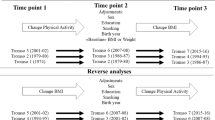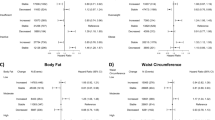Abstract
Objective:
To investigate the relationship of body weight and its changes over time with physical activity (PA).
Design:
Population-based prospective cohort study (Norfolk cohort of the European Prospective Investigation into Cancer and Nutrition, EPIC-Norfolk, United Kingdom).
Subjects:
A total of 25 639 men and women aged 39–79 years at baseline. PA was self-reported. Weight and height were measured by standard clinical procedures at baseline and self-reported at 18-month and 10-year follow-ups (calibrated against clinical measures). Main outcome measure was PA at the 10-year follow-up.
Results:
Body weight and PA were inversely associated in cross-sectional analyses. In longitudinal analyses, an increase in weight was associated with higher risk of being inactive 10 years later, after adjusting for baseline activity, 18-month activity, sex, baseline age, prevalent diseases, socioeconomic status, education, smoking, total daily energy intake and alcohol intake. Compared with stable weight, a gain in weight of >2 kg per year in the short-, medium- and long-term was consistently and significantly associated with greater likelihood of physical inactivity after 10 years, with the most pronounced effect for long-term weight gain, OR=1.89 (95% CI: 1.30–2.70) in fully adjusted analysis. Weight gain of 0.5–2 kg per year over long-term was substantially associated with physical inactivity after full adjustment, OR=1.26 (95% CI: 1.11–1.41).
Conclusion:
Weight gain (during short-, medium- and long-term) is a significant determinant of future physical inactivity independent of baseline weight and activity. Compared with maintaining weight, moderate (0.5–2 kg per year) and large weight gain (>2 kg per year) significantly predict future inactivity; a potentially vicious cycle including further weight gain, obesity and complications associated with a sedentary lifestyle. On the basis of current predictions of obesity trends, we estimate that the prevalence of inactivity in England would exceed 60% in the year 2020.
This is a preview of subscription content, access via your institution
Access options
Subscribe to this journal
Receive 12 print issues and online access
$259.00 per year
only $21.58 per issue
Buy this article
- Purchase on Springer Link
- Instant access to full article PDF
Prices may be subject to local taxes which are calculated during checkout
Similar content being viewed by others
References
World Health Organization The challenge of obesity in the WHO European Region and the strategies for response In Branca F, Nikogosian H, Lobstein T eds WHO Regional Office for Europe Copenhagen, 2007.
Miles L . Physical activity and health. Br Nutr Found Nutr Bull 2007; 32: 314–343.
Department of Health Health Survey for England 2004 2004.
Emphasis: The East Midlands public health network. The health benefits of physical activity, 2004. Internet: http://www.emphasisnetwork.org.uk/networks/activity/benefits.htm (accessed 1 May 2010).
Barsh GS, Farooqi IS, O'Rahilly S . Genetics of body-weight regulation. Nature 2000; 404: 644–651.
Hill JO, Peters JC . Environmental contributions to the obesity epidemic. Science 1998; 280: 1371–1374.
Rosengren A, Lissner L . The sociology of obesity. Front Horm Res 2008; 36: 260–270.
Hutcheon JA, Chiolero A, Hanley JA . Random measurement error and regression dilution bias. BMJ 340: c2289.
Fogelholm M, Kukkonen-Harjula K . Does physical activity prevent weight gain–a systematic review. Obes Rev 2000; 1: 95–111.
Haapanen N, Miilunpalo S, Pasanen M, Oja P, Vuori I . Association between leisure time physical activity and 10-year body mass change among working-aged men and women. Int J Obes Relat Metab Disord 1997; 21: 288–296.
Klesges RC, Klesges LM, Haddock CK, Eck LH . A longitudinal analysis of the impact of dietary intake and physical activity on weight change in adults. Am J Clin Nutr 1992; 55: 818–822.
Besson H, Ekelund U, Luan J, May AM, Sharp S, Travier N et al. A cross-sectional analysis of physical activity and obesity indicators in European participants of the EPIC-PANACEA study. Int J Obes 2009; 33: 497–506.
Ekelund U, Brage S, Besson H, Sharp S, Wareham NJ . Time spent being sedentary and weight gain in healthy adults: reverse or bidirectional causality? Am J Clin Nutr 2008; 88: 612–617.
Bak H, Petersen L, Sorensen TI . Physical activity in relation to development and maintenance of obesity in men with and without juvenile onset obesity. Int J Obes Relat Metab Disord 2004; 28: 99–104.
Mortensen LH, Siegler IC, Barefoot JC, Gronbaek M, Sorensen TI . Prospective associations between sedentary lifestyle and BMI in midlife. Obesity 2006; 14: 1462–1471.
Petersen L, Schnohr P, Sorensen TI . Longitudinal study of the long-term relation between physical activity and obesity in adults. Int J Obes Relat Metab Disord 2004; 28: 105–112.
Christiansen E, Swann A, Sorensen TI . Feedback models allowing estimation of thresholds for self-promoting body weight gain. J Theor Biol 2008; 254: 731–736.
Brown M, Byatt T, Marsh T, McPherson K . Obesity Trends for Adults Analysis from the Health Survey for England 1993–2007: National Heart Forum, 2010.
Riboli E . Nutrition and cancer: background and rationale of the European Prospective Investigation into Cancer and Nutrition (EPIC). Ann Oncol 1992; 3: 783–791.
Ishihara LS, Khaw KT, Luben R, Bingham S, Welch A, Day N et al. Self-reported parkinsonian symptoms in the EPIC-Norfolk cohort. BMC Neurol 2005; 5: 15.
Khaw KT, Jakes R, Bingham S, Welch A, Luben R, Day N et al. Work and leisure time physical activity assessed using a simple, pragmatic, validated questionnaire and incident cardiovascular disease and all-cause mortality in men and women: The European Prospective Investigation into Cancer in Norfolk prospective population study. Int J Epidemiol 2006; 35: 1034–1043.
Wareham NJ, Jakes RW, Rennie KL, Mitchell J, Hennings S, Day NE . Validity and repeatability of the EPIC-Norfolk Physical Activity Questionnaire. Int J Epidemiol 2002; 31: 168–174.
Wareham NJ, Jakes RW, Rennie KL, Schuit J, Mitchell J, Hennings S et al. Validity and repeatability of a simple index derived from the short physical activity questionnaire used in the European Prospective Investigation into Cancer and Nutrition (EPIC) study. Public Health Nutr 2003; 6: 407–413.
The InterAct Consortium Validity of a short questionnaire to assess physical activity in 10 European countries (EPIC-InterAct Study). Eur J Epidemiol 2011; 27: 15–25.
McFadden E, Luben R, Wareham N, Bingham S, Khaw KT . Occupational social class, educational level, smoking and body mass index, and cause-specific mortality in men and women: a prospective study in the European Prospective Investigation of Cancer and Nutrition in Norfolk (EPIC-Norfolk) cohort. Eur J Epidemiol 2008; 23: 511–522.
Shohaimi S, Luben R, Wareham N, Day N, Bingham S, Welch A et al. Residential area deprivation predicts smoking habit independently of individual educational level and occupational social class. A cross sectional study in the Norfolk cohort of the European Investigation into Cancer (EPIC-Norfolk). J Epidemiol Community Health 2003; 57: 270–276.
Bingham SA, Gill C, Welch A, Cassidy A, Runswick SA, Oakes S et al. Validation of dietary assessment methods in the UK arm of EPIC using weighed records, and 24 h urinary nitrogen and potassium and serum vitamin C and carotenoids as biomarkers. Int J Epidemiol 1997; 26(Suppl 1): S137–S151.
May AM, Bueno-de-Mesquita HB, Boshuizen H, Spijkerman AM, Peeters PH, Verschuren WM . Effect of change in physical activity on body fatness over a 10-y period in the Doetinchem Cohort Study. Am J Clin Nutr 92: 491–499.
Wareham NJ, van Sluijs EM, Ekelund U . Physical activity and obesity prevention: a review of the current evidence. Proc Nutr Soc 2005; 64: 229–247.
Summerbell CD, Douthwaite W, Whittaker V, Ells LJ, Hillier F, Smith S et al. The association between diet and physical activity and subsequent excess weight gain and obesity assessed at 5 years of age or older: a systematic review of the epidemiological evidence. Int J Obes 2009; 33(Suppl 3): S1–S92.
Hankinson AL, Daviglus ML, Bouchard C, Carnethon M, Lewis CE, Schreiner PJ et al. Maintaining a high physical activity level over 20 years and weight gain. JAMA 304: 2603–2610.
Lee IM, Djousse L, Sesso HD, Wang L, Buring JE . Physical activity and weight gain prevention. JAMA 303: 1173–1179.
Wouters EJ, Larsen JK, Zijlstra H, van Ramshorst B, Geenen R . Physical activity after surgery for severe obesity: the role of exercise cognitions. Obes Surg 21: 1894–1899.
Bond DS, Phelan S, Leahey TM, Hill JO, Wing RR . Weight-loss maintenance in successful weight losers: surgical vs non-surgical methods. Int J Obes 2009; 33: 173–180.
Bond DS, Phelan S, Wolfe LG, Evans RK, Meador JG, Kellum JM et al. Becoming physically active after bariatric surgery is associated with improved weight loss and health-related quality of life. Obesity 2009; 17: 78–83.
Silver HJ, Torquati A, Jensen GL, Richards WO . Weight, dietary and physical activity behaviors two years after gastric bypass. Obes Surg 2006; 16: 859–864.
Josbeno DA, Jakicic JM, Hergenroeder A, Eid GM . Physical activity and physical function changes in obese individuals after gastric bypass surgery. Surg Obes Relat Dis 6: 361–366.
Levine JA, Eberhardt NL, Jensen MD . Role of nonexercise activity thermogenesis in resistance to fat gain in humans. Science 1999; 283: 212–214.
Berentzen T, Sorensen TI . Physical inactivity, obesity and health. Scand J Med Sci Sports 2007; 17: 301–302.
Hu FB, Willett WC, Li T, Stampfer MJ, Colditz GA, Manson JE . Adiposity as compared with physical activity in predicting mortality among women. N Engl J Med 2004; 351: 2694–2703.
Acknowledgements
We are grateful to all the volunteers who devoted their valuable time to participate in the EPIC-Norfolk study. We would also like to thank Amit Bhaniani for his assistance with data management. EPIC-Norfolk is financially supported by program grants from Cancer Research Campaign and Medical Research Council with additional support from the Stroke Association, British Heart Foundation, Department of Health, Food Standards Agency and the Wellcome Trust. Rajna Golubic is financially supported by a scholarship from the Gates Cambridge Trust.
Author information
Authors and Affiliations
Corresponding author
Ethics declarations
Competing interests
The authors declare no conflict of interest.
Additional information
Supplementary Information accompanies the paper on International Journal of Obesity website
Supplementary information
Rights and permissions
About this article
Cite this article
Golubic, R., Ekelund, U., Wijndaele, K. et al. Rate of weight gain predicts change in physical activity levels: a longitudinal analysis of the EPIC-Norfolk cohort. Int J Obes 37, 404–409 (2013). https://doi.org/10.1038/ijo.2012.58
Received:
Revised:
Accepted:
Published:
Issue Date:
DOI: https://doi.org/10.1038/ijo.2012.58
Keywords
This article is cited by
-
Association of weight change across adulthood with hearing loss: A retrospective cohort study
International Journal of Obesity (2022)
-
The bidirectional associations between leisure time physical activity change and body mass index gain. The Tromsø Study 1974–2016
International Journal of Obesity (2021)
-
Adiposity and changes in movement-related behaviors in older adult women in the context of the built environment: a protocol for a prospective cohort study
BMC Public Health (2019)
-
Physical Activity in the Prevention of Weight Gain: the Impact of Measurement and Interpretation of Associations
Current Obesity Reports (2019)
-
Using open source accelerometer analysis to assess physical activity and sedentary behaviour in overweight and obese adults
BMC Public Health (2018)



